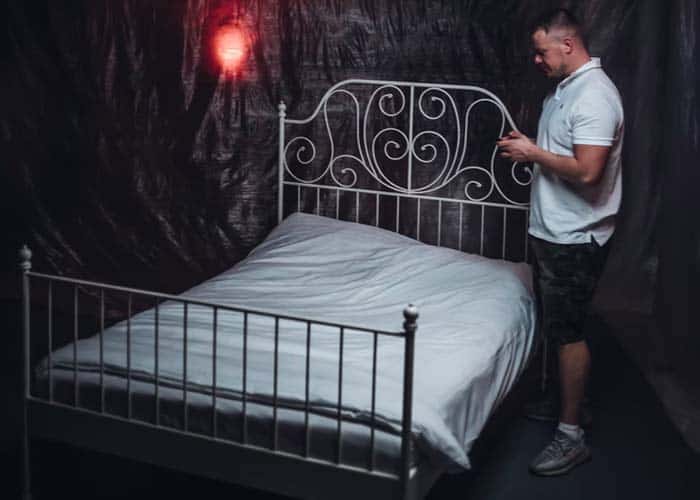Let’s face it, at some time, we all experience the annoying squeaky bed, but for some reason, we tolerate the noise until it becomes so bad there is no choice but to take action.
Fixing a squeaky bed is often a daunting task, mainly due to the cumbersome nature of a bed. We need to strip the mattress and remove it, which is often a two-man job, and then the thought of isolating the irritating squeak seems to be as bad as performing major surgery.
However, in the interests of restful night sleep, it’s an unavoidable job that is best-tackled head-on.
In this brief article, I hope to give you some tips and hints on the easiest and best way to fix the problem without too much hassle and stress.
Identifying the problem
Identifying the elusive squeak can be more complicated than first meets the eye. Is it the frame? Is it the mattress? Or a combination of things, including wear and tear.
If you have a traditional frame for a bed, start at each corner and try to rock the bed. If the bed moves, it is more than likely the fixings require tightening.
For older beds, you will require a screwdriver. Depending on the age of the bed frame, you may need a flat head screwdriver.
Remove the mattress; this will allow you to tighten the screw fixings tighter due to less resistance caused by the mattress.
The order you tighten the screw fixings will have no impact on the outcome so, start with the base and tighten the screws as much as you can, Then do the same at the head of the bed.
At this point, while you have your screwdriver at hand, check the headboard. If your frame has a separate headboard, you will notice each side typically has two fixings, tighten both fixings on each side. This should give you a rigid headboard.
You may find that lightly lubricating the screws with something like 3 in 1 oil will give you better results.
Using lubricant sparingly drips and runs onto a carpet will be challenging to remove and will become an eyesore over time.
Ok, so now the bed frame is tight and free from rattles and squeaks. Replace the mattress and check if the problem is solved.
At this point, it is also worth mentioning that flipping the mattress and rotating the mattress is a reasonable idea and may make your mattress more comfortable.
Is the squeak still not fixed?
Let’s delve deeper into the squeak issues. Assuming that the bed frame is tight after completing the above procedures and there are no squeaks before placing the mattress on the frame, the issue must be something else.
Now, with the mattress’s weight on the frame, just retighten all of the fixings to ensure the frame is tight and secure.
With older frames, steel and timber, the holes may have enlarged through wear and tear, which has introduced some unwanted play or movement. If this is the case, it may need a trip to your local DIY.
You may need to use more significant fixings by drilling out the original holes to a size acceptable. It’s a drastic step and one that may only be a short term fix.
If your bed frame is antique, it may be advisable to get a professional to fix the problem.
Packing joints with a cork or a thin rubber gasket will also solve the problem as long as you tighten sufficiently to make good frictionless contact with the mating surfaces.
If your bed frame is just old, then it’s worth a try, but ultimately you will be better off with a new bed frame and possible mattress.
It is also worth noting that some beds (depending on age) will always have some movement. This movement depends on the temperature and humidity of the bedroom. The wood expands and contracts by a fraction of a millimetre across the year with changing weather patterns.
The above will apply to steel frame beds also. However, steel is less susceptible to small temperature changes and is not affected by humidity.
How Long Does the Bed Frame Last?
This is a great question to ask, I’m sure many of you have different answers to offer.
As with most things, the price you pay will factor into the quality of the bed frame so let us talk on averages. You paid an average price, you are an average weight, and you live in an average heated home.
Is there such a thing as averages?
Assuming an average, a medium price bed frame should last in the region of a decade if not more. Now, If you swing from the chandeliers regularly the frame may last a shorter time.
If your children use your bed as a trampoline, then this will shorten the life of the frame. It’s only to be expected and a reasonable assumption.
Saggy Box Spring Mattress
Assuming that we have fixed all the problems with the bed frame and we are happy that all aspects of squeaking joints have been resolved but we still have a problem, we need to take a close look at the mattress.
Our bed mattresses take some punishment over time, yet we give little to no thought about our mattress unless we have a spring sticking in our skin!
Of course, the mattress wears like anything else. Box spring mattresses become saggy as the springs lose their ability to reform to their original shape,
When the mattress becomes saggy, the springs tend to drag on the wooden slats of the base of the bed, catching and snagging.
The fix for this problem is not so simple as flipping the mattress.
A good fix for saggy box spring mattresses is to line the base of the bed with plywood. An even surface for the mattress will eliminate snagging and noise generated by the mattress as we toss and turn at night while we sleep.
Apart from the dragging and snagging the springs, when worn and deteriorating, come into contact with one another and rub. This causes the squeaky mattress that spring mattress owners may encounter over time.
Is There a Solution For Squeaky Box Spring Mattresses?
It is possible to stop or reduce the squeaking mattress.
First, you may wish to lubricate the spring coils, using a light lubricant like WD 40 will help in the short term. However, depending on the scale of the problem WD 40 will only be a quick fix but not permanent, plus WD 40 does have a distinct odour which you may find intolerable or even offensive in the bedroom.
It is possible to pack around the springs with a suitable material to stop the springs from rubbing against one another.
To be honest with you, if you are at this point with your mattress, I think it’s high time for a new mattress!
How Long Will My Box Spring Mattress last?
Again if we talk about averages as we did above and fair wear and tear, your mattress should last the same as your bed frame, around 10 years. After this point, you will need to make an assessment if it needs replacing. It’s worth saying if you have a regularly maintained bed frame and mattress, it could last substantially longer than ten years.
As with most things these days, you get what you pay for. If you have bought a quality piece of bedroom furniture made from hardwood you could expect a lifer time if using.
The materials used in the construction of beds and mattresses vary greatly and have an enormous impact on the longevity of your bedroom furniture over time.
Other Serviceable Points That Need Maintenance
We didn’t talk about castors and wheels. Wheels and castors on bed frames are great on wooded and hard floors, but they offer very little in terms of ease of movement on the carpet.
However, They are worth looking at if you have an annoying squeak, and it is always good housekeeping to give the wheels a quick clean once in a while.
Due to the nature of the construction of the wheels, it is inevitable they will pick up carpet fibres that invariably wrap around the spindles, causing jamming and wear.
Although the wheels are almost defunct on the carpet when they wear can become a source of irritation with squeaking and grinding.
Keep the wheels cleaned and lubricated for the best performance over the life of the bed frame.
Do wood or metal bed frames squeak more?
As a general rule, a wooden bed frame squeaks less than a metal one because wood-on-wood friction is less likely to cause noise. On the other hand, the sound of metal scraping against metal is much louder. Furthermore, wood is durable enough for it to be tightened more securely than metal, ensuring that the bolts and screws will not make any noise.
Conclusion
Your bed and mattress are not maintenance-free. Over time, if you regularly adhere to a schedule of checking the tightness of your bed frame fixings’ tightness and flipping your mattress, your bed and mattress should provide years of restful nights.
Don’t forget to vacuum your mattress dust covers. This will increase the life of your mattress and prevent ingress of dust to the internal components of the mattress, thus extending the life.

 Nectar Mattress
Nectar Mattress 


